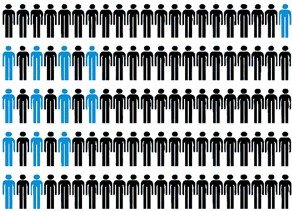Stammering and Brain
Here, we will show you how our Neuro-AI pipeline uncovered consistent differences in brain structure, functional activity, and overall behavioral patterns in over 80% of people who stammer – proving that stammering is a neurodevelopmental condition, not just a habit.
Neuro-AI Insights : Common Brain Patterns in People Who Stammer
Stammering is more than just a speech disruption – It’s a complex neurodevelopmental condition with consistent brain-level signatures. Leveraging our Neuro-AI pipeline, we applied deep learning-based segmentation, pattern clustering, and temporal trend analysis on brain imaging and behavioral datasets across cohorts Classified by stammering intensity, psychological profiles, and associated neurodevelopmental traits. Here, we reveal key findings and trends that emerged from our large-scale analysis.
The illustration below summarizes key differences, recurring patterns, and emerging trends derived from multi-modal brain imaging data, captured before and after specific interventions, and analyzed across diverse individual factors.
Here, PWS refers to People Who Stammer, and Non-PWS refers to those without stammering. The datapoints below are collected from comparisons between PWS v/s Non-PWS.
This section is presented in a simple and easy-to-understand way for a general audience. More detailed and technical information can be found in the my technical research papers.
People Who Stammer
Analysis based on five observed batches, each comprising 10 individuals with varied age groups, genders, and professional backgrounds.
No Data Found
People Without Stammering
Analysis based on five observed batches, each comprising 10 individuals with varied age groups, genders, and professional backgrounds.
No Data Found
Frequently observed Neurobiological Features
why they matter and how they affect speech
We checked, analysed existing research worldwide in the field of speech and hearing sciences. Common abnormalities observed include differences between the left and right hemispheres of the brain. Several studies indicate that activation in specific brain areas related to speech production, particularly the basal ganglia, differs in certain conditions. We took this as a base and then tried to identify common patterns and trend across multiple subjects brain imaging modalities
1 : Abnormal White Matter
Observation : Disruptions in white matter tracts, especially in left-hemisphere speech pathways.
Why it matters : In simple words, White matter tracts act like high-speed data cables connecting brain regions. In speech, the arcuate fasciculus links Broca’s area (speech planning) with Wernicke’s area (language comprehension). If the “wiring” is faulty, the signal between planning and speaking gets delayed or distorted.
Impact on speech:
- Slower coordination between thought and articulation.
- Increased likelihood of repetitions or blocks.
Example : In many PWS, the left arcuate fasciculus is thinner or less organized, similar to a frayed internet cable slowing down connection speed.
2 : Overactivity in the Right Hemisphere
Observation: Excessive activation in right-hemisphere brain regions, especially during speech tasks.
Why it matters: The left hemisphere is typically dominant for language. When it underperforms, the right hemisphere often tries to compensate or make adjustments. However, this compensation is less efficient for rapid, fluent speech.
Impact on speech:
- Over-reliance on slower processing pathways.
- Speech may become effortful or rhythmically irregular.
Example: A PWS may activate the right frontal lobe more than a fluent speaker, similar to using your non-dominant hand for writing – possible, but slower and less precise.
3 : Underactivity in Broca’s Area
Observation: Reduced activation in Broca’s area in the left frontal lobe.
Why it matters: Broca’s area is the speech production hub, responsible for sequencing sounds, forming words, and structuring sentences. It’s also crucial for motor planning in speech.
Impact on speech:
- Difficulty initiating speech.
- Increased pauses and blocks.
- Reduced fluency under time pressure.
Example: In imaging studies, Broca’s area in PWS lights up less during speaking tasks compared to fluent speakers, like a low-powered motor struggling to run at full speed.
4 : Disrupted Timing Networks
**Most Important**
Observation: Irregularities in cerebellum and related timing coordination circuits.
Why it matters: The cerebellum acts as the brain’s metronome, ensuring precise timing in speech muscles. Any disruption here can throw off rhythm, similar to a drummer losing beat in a band.
Impact on speech:
- Speech rhythm becomes uneven.
- Increased tendency for syllable prolongation or sudden breaks.
Example: Some PWS show delayed activation in cerebellar regions, which can make speech timing unpredictable.
5 : Basal Ganglia Irregularities
Observation: Differences in basal ganglia circuits, which help regulate movement initiation and smooth transitions between actions.
Why it matters: In speech, the basal ganglia control the start-stop mechanism of articulatory movements. When timing signals are disrupted, speech may halt unexpectedly or repeat unnecessarily.
Impact on speech:
- Frequent speech blocks.
- Difficulty maintaining smooth verbal flow.
Example: In Parkinson’s disease (which also affects the basal ganglia), patients often experience speech hesitations—suggesting a shared neural mechanism with stammering.
People Who Stammer
Disrupted Timing Networks
No Data Found
People Without Stammering
Disrupted Timing Networks
No Data Found
People Who Stammer
Activation Patterns
No Data Found
People Without Stammering
Activation Patterns
No Data Found
Loading..........
The Data is Not Available
More detailed and technical information can be found in the my technical research papers.
Final Outcomes and Understanding
These findings confirm that stammering is not caused by anxiety, nervousness, breathing issues, lack of intelligence, being unprepared or any general physiological or physiological weakness or factor – as these are common myths. But rather by measurable brain differences in structure and function., these are common myths but rather by measurable brain differences in structure and function. Many of these differences appear early in life, with subtle structural changes and more pronounced functional adaptations developing over time, ultimately becoming the individual’s “Default Setting”. This supports the classification of stammering as a neurodevelopmental condition.
People without Stammering
People with Stammering

- Disrupted Timing Networks – 33%
- Overactivity in the Right Hemisphere – 12%
- Underactivity in Broca’s Area – 28%
- Abnormal White Matter – 21%
- Basal Ganglia Irregularities – 17%

- Disrupted Timing Networks – 92%
- Overactivity in the Right Hemisphere – 89%
- Underactivity in Broca’s Area – 84%
- Abnormal White Matter – 70%
- Basal Ganglia Irregularities – 78%
~34%
People without Stammering
>80%
People with Stammering
With this clear understanding of the outcomes and common patterns from above Research Work, the next step was to design a solution that directly addresses the challenges faced by people who stammer or experience other speech-related issues. The goal was not only to process and interpret speech-related data, but to transform these findings into easy, practical, effective and accessible tools. Our design process began with mapping the user journey – from initial assessment to measurable improvement-ensuring that every feature was purposeful and user-friendly. The goal was also to ensure that the solution’s implementation and validation remained fully traceable through measurable techniques and progress indicators.
Objectives:
- Address the Root Causes – Focus on speech realignment, timing networks and blockage recovery.
- Eliminate Ineffective Methods – Move away from common but less effective practices such as excessive breathing drills or mere repetition etc.
- Track Progress Scientifically – Monitor improvements using neuroimaging and other reliable measures.
Let’s Beat Your Stammering
3 Step Solution
A Practical Solution Combining Speech Realignment, Blockage Recovery and Subtle Lifestyle Changes
Stammering Life Guide
Life Guide that will help you to Strategize Every Important Milestone of Your Journey
Speech Fluency Tools
Tools designed to help individuals overcome stammering and related speech and neurodevelopmental conditions.



 You can report directly via our Contact Form or email us at below emails.
You can report directly via our Contact Form or email us at below emails.